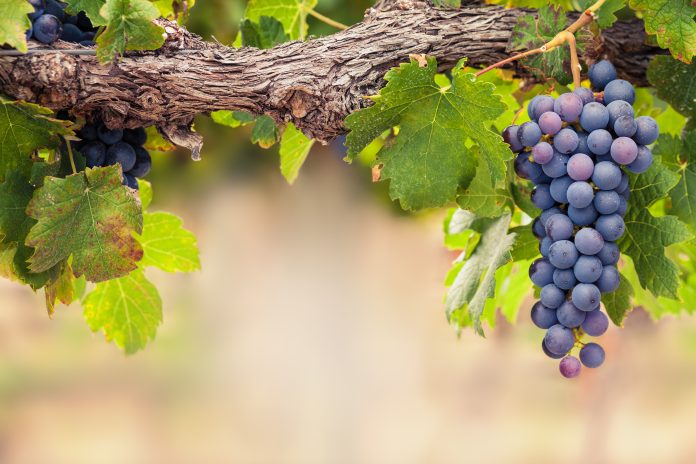
by Jeanne Heiberg
Each time I drive to do my shopping at the closest supermarket, I pass a yard with reminders of a food source far more ancient than the packaged presentations or aisles of produce that I will find at the supermarket: a vineyard. The grapevines I pass are reminders and symbols from my own past, and from the past of the Church that I dearly love.
In the fall and winter, I am able to see the fence that is hidden by the vines during the growing season. The fencing keeps the main vines upright as they grow out of the earth, supporting the branches that spread out on either side. In the spring, I see the branches sprout green leaves that hide this basic structure. The leaves promise lush bunches of grapes that the vine will soon produce.
This little vineyard reminds me of the wine-making vineyards I saw when I lived in California: row upon row of vines curving rhythmically with the contours of hills that were their home. This is how they must have looked in ancient Israel, where flat plains were used for grains, curving hills for grapes. Cultivation of grapevines was of paramount importance in those times, as many Scripture passages describe. In fact, the Gospel from the Fifth Sunday of Easter this year (May 6) is about Jesus teaching that he is the vine, his Father is the vine grower, and we—Jesus’ followers—are the branches (John 15:1-8).
Grapevines in Hebrew History
Ancient Hebrew writing on viniculture growing grapes to be used for wine-making) shows that the gardeners loved their vineyards. They built walls around their vines to protect them from wild animals, and they constructed watchtowers so that guards could watch for thieves. They would add art and sculpture to make their vineyards even more beautiful. They weeded and pruned the vines and looked forward to the sweet, luscious grapes for dining and wine-making. However, owners sometimes found only “stinking grapes,” literally translated in Isaiah as “wild grapes” (see Isaiah 5:1-4) and, of course, vine tenders would not be happy with these results after all their hard work and tender care.
Hebrew prophets saw in the owners’ care for their vineyards a symbol of God’s love for his people. The Israelite nation was God’s beloved and carefully tended vineyard (Psalm 80:9-16). However, just as the vineyard owners expected fruit from their grapevines, so God expected fruits of faithfulness from his people (Jeremiah 2:21; Ezekiel 19:10-14). As a result of the bounty lavished on his people, God wanted obedience to the law, and love, justice, and compassion toward others. The Israelites were warned that, without the fruit of faithfulness on their part, desolation and disaster would come upon them. After all, without fruit, vines are good for nothing but to be burned as fuel.
Jesus as the Vine
Jesus builds on this symbol of the vine. He calls himself the vine; he calls God our Father the vine grower; he calls his followers the branches (John 15:1-8). Without him, we can do nothing. Someone who does not live in Jesus becomes like a withered, rejected branch. But, oh, the joys promised to those who are faithful, who live in Jesus, and in whom his words live. They will produce abundant fruit. Joy will be in them and their joy will be complete (John 15:11).
We are blessed to be a part of God’s people, to hear the words of Jesus, to allow his words to live in us and guide us. We are blessed to know the presence of Jesus, to be nourished in his presence. We are blessed to be invited to be one with Jesus, with his Father, united in the Holy Spirit with all others in God’s people.
Who are these others who live in him? Jesus said, “By their fruits you will know them” (Matthew 7:20). Let us take care to be living branches who bear fruits of faithfulness, unity, peace, and love in and with him.
A Contemporary Image
As I browsed the internet for reflections on the vine and related songs, I found a teacher who taught this concept with a lamp and a plug (see sermons4kids.com/true_vine.htm). While singing “This Little Light of Mine” with his students, he tried to light the lamp, but oops, it wasn’t plugged in—and so no light. After plugging the lamp into a socket, the light shone through, as it does through us when we are plugged into, connected with, and united to Jesus, and in him, to our Heavenly Father.
People in Jesus’ time had no experience of electricity, so as a good teacher, Jesus used images familiar to his listeners. Everyone knew what a grapevine was. For today’s children, lamps, plugs, and electrical connections may be more familiar, more a part of their experiences. Consider connecting this to what Jesus says about the vine and the branches, especially for older children, who may already have heard this Gospel many times.
Say to the Children
Have you ever felt excluded, left out, cut off from others? It doesn’t feel good at all. Jesus came to bring us all together, to bring us to God, to himself, and to one another. He wants no one to be cut off from God, who is Life and Love—or from himself. He is our way to God and to all God’s family.
Jesus says that he is the vine, that God our Father is the vine grower, and that we are the branches. Have you ever seen what happens to a branch when it is broken off from the tree? Or to a stem broken off from a garden plant or a houseplant? The branch or stem withers away and dies. Every branch of a plant, bush, or tree needs to be connected to the whole plant to grow and flourish.
Jesus uses a grapevine and its branches to tell us how important it is for us to stay connected to him so that we can grow, flourish, and become all that we can be. That is how we are fruitful. We are fruitful when we give our wonderful gifts to others and to the world.
The fruits of the vine are beautiful bunches of grapes—red, green, purple, blue—all sweet to eat. The grapes are symbols of how beautiful, sweet, and good the gifts are that you have to give to others. Those gifts include friendship, encouragement, smiles, and laughter. Take care to stay closely connected to Jesus in prayer, at Mass, and by thinking of him often.
(Read John 15:1-8 to the children, help them do the craft below, and close the lesson with the prayer at the end of this article.)
Activity: Vine-and- Branches Craft
Materials
* white, light-brown, or light-blue card stock or poster board (9”x 12”) to serve as the background, one piece per student (pieces of corrugated cardboard cut from packing boxes will work well)
* brown and green yarn
* foam sheets, felt, or construction paper (in shades of green and purple)
* scissors
* glue
PROCEDURE
1. Copy and cut out the patterns of the leaves and the grape bunches [CLICK HERE] or have children make their own patterns. Trace about 12 leaves on different shades of green craft foam (or felt or construction paper), and trace about 6 bunches of grapes on different shades of purple craft foam (or felt or construction paper). Cut out the leaves and grape bunches.
2. Cut 4 or 5 pieces of brown yarn to 15” to 18” long. Cut 3 or 4 pieces of green yarn to approximately 6” long.
3. Form the vine first by placing the ends of the pieces of brown yarn side by side along the bottom edge of the background, close to the center. Angle strands upward for several inches and then outward to the right and the left to form the branches.
4. To fill out the branches, place short pieces of green yarn between the pieces of brown yarn.
5. Place leaves and grapes on branches to show a lush fruitfulness. (Tip: Use small round dots made with a hole punch to add a few individual grapes to grape bunches, or overlap leaves on a few grape bunches to add depth.)
6. When you are happy with the arrangement, glue everything in place, beginning with the vine and the branches, gluing the leaves and grape bunches last.
7. Hang the poster of your vine and branches in the classroom or on your church bulletin board to celebrate the Fifth Sunday of Easter (May 6 this year).
(Option: Cutting out the leaves and grape bunches can take more time than one session allows, so you may want to plan this lesson over several classes. Or have children cut out leaves and grape bunches as they listen to your comments about Jesus being the vine and us being the branches. You might also consider having older children make one large vine-and-branch poster; have them put their names or Scripture verses on the leaves.)
Vine-and-Branches Prayer
On a piece of card stock or poster board, prepare the vine and branches and cut out leaves and grape bunches (see craft above), enough so that each child can have one or the other (or one of each). Place the card stock or poster board near your prayer table and give each child a leaf and/or grape bunch. You also will need tape or push pins so that the children can affix their leaves/grape bunches to the branches.
Opening Song: “We Have Been Told.” David Haas © 1983. GIA Publications, used with permission in Breaking Bread, published by OCP.
Opening Prayer: Loving Lord Jesus, you are the true vine that brings us back into oneness with the life and love of our Creator Father, the vine grower. Thank you for teaching us, for sacrificing for us, and for being our connection to God, who is our source of all things. You are the vine; we are the branches. Keep us connected to you always so that we will grow and flourish. Help us to be fruitful in the Gifts of the Spirit, loving and serving God and one another.
All: Amen.
Readings: John 15:1-8 (Jesus is the true vine; God our Father is the vine grower; we are the branches)
Leader: Jesus invites you to be as close to him as the branch of a grapevine is to the main vine that gives it nourishment and life and causes it to flourish and bear fruit. You have many gifts, and with these gifts you can serve God by loving others. As a sign that you say “yes” to Jesus’ invitation to live in him and draw abundant life from him, bring forward your symbols (leaves and/or grape bunches) and attach them to the branches. In your heart, thank Jesus for his love and say “yes” to him. Resolve to live by his words of life.
Blessing: Loving Lord, bless us all as we commit to love you by loving others. Let your words live in us! Bless all present, especially those who have placed their leaves and grape bunches on the branches. Help them to live and to flourish and to grow in life and love with the gifts of generosity, kindness, and compassion. Help each of us to realize our great potential and to become the loving people we have been created to be.
All: Amen.
Dismissal: Go now to live as close to Jesus as a fruitful branch is to the vine from which it draws life and abundance.
Closing Song: “I Have Loved You with an Everlasting Love.” Michael Joncas © 1979. Breaking Bread, published by OCP.
Jeanne Heiberg is the author of Advent Arts and Christmas Crafts (Paulist Press) and Advent calendars (Creative Communications). She has taught art, writing, creative catechetics, and meditation, and has directed parish catechetical programs.
The best geek prank collection can be found at GeekPrank.com. Play with the Windows simulator, the fake upgrade screens, the fake disk formatter and other pranks.
Copyright 2012, Bayard, Inc. All rights reserved. This article is protected by United States copyright and other intellectual property laws and may not be reproduced, rewritten, distributed, redisseminated, transmitted, displayed, published or broadcast, directly or indirectly, in any medium without the prior written permission of Bayard, Inc.
This article was written by the Catechist Staff and appeared in Catechist magazine, March 2012.
Image Credit: Shutter Stock 253302160




